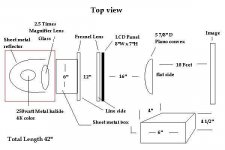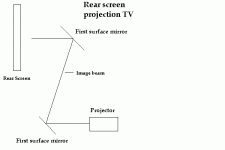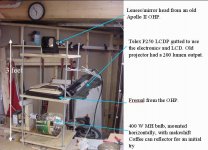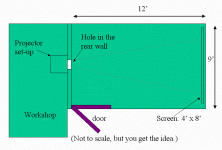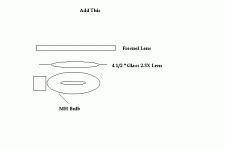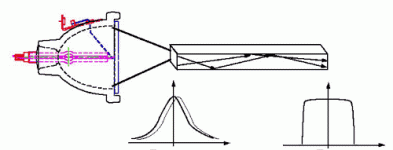can anyone find the specs of an Eiki LC 300 for me??? A friend wants to sell it for $200 working, but if I can get better looking building one I would rather do that
Mitch
First you need to square off the light by using a metal box.
Use a piece of cardboard at each end of lens to see how the light pattern is turning out. This is also a good way to determine distance. Your panel will work, but will need a 400watt MH for
brighter image (bigger panel). The lens you have will work, but then you will need alot more distance from Plano to screen.
I got mine (5 7/8" Diameter Plano convex Lens) for 8 bucks at
the surplus shed. The total length of my projector is about 42"
long, but hey I dont care, you should see my 90" TV.
Perfect clarity on all four corners, no centre hot spots, and this is on a white bed sheet. My friends freak out on this.
Later
First you need to square off the light by using a metal box.
Use a piece of cardboard at each end of lens to see how the light pattern is turning out. This is also a good way to determine distance. Your panel will work, but will need a 400watt MH for
brighter image (bigger panel). The lens you have will work, but then you will need alot more distance from Plano to screen.
I got mine (5 7/8" Diameter Plano convex Lens) for 8 bucks at
the surplus shed. The total length of my projector is about 42"
long, but hey I dont care, you should see my 90" TV.
Perfect clarity on all four corners, no centre hot spots, and this is on a white bed sheet. My friends freak out on this.
Later
Attachments
amblix1
It looks like it is an older video only projector. Not a bad unit, but remember that the bulbs on these are expensive, i believe it uses a MH that costs 289.00 at bulbman.com so factor that into the cost and decide if its worth it to you
It looks like it is an older video only projector. Not a bad unit, but remember that the bulbs on these are expensive, i believe it uses a MH that costs 289.00 at bulbman.com so factor that into the cost and decide if its worth it to you
eebasist said:amblix1
It looks like it is an older video only projector. Not a bad unit, but remember that the bulbs on these are expensive, i believe it uses a MH that costs 289.00 at bulbman.com so factor that into the cost and decide if its worth it to you
thats one part I dont like, I saw a screenshot and it looks very promising though. Whats the life expectancy on those bulbs do you know? Also do most commercial projectors have Zoom so I dont have to keep moving the projector going from 16:9 to 4:3, I want my screen to be 16:9 because as furniture it looks much better. Also with an OHP setup how do you do this? Just move the OHP back and forth?
with an OHP you move the whole system since its not a zoom lens. Not all commercial projectors have zoom, most of the cheaper ones obviously dont. The 160watt MH in the Eiki i believe is rated for either 1000 or 2000 hours, so you never really know how much life is really left on it. Although you could try and put a different MH bulb in there with a replacement ballast, but again it adds into the cost, if you want something to watch a couple hours a week and just throw away then 200$ is a good deal, but if you want this for long term viewing, it might not be as good a deal
Redevil,
Thanks for your help. Drawing up those diagrams was above and beyond.
There are a few more things I had questions about. How big is your 2.5x magnifier? Is this a page magnifier sheet, or a round lens?
I just looked at the surplus shed and they didn`t seem to have any 5 7/8" PCX lenses. But they did have a 4 1/2 with a 12" FL. So I`ll proabbly get that.
I think I`m going to use two smaller MH lights instead of one big one. This might help with the light dispersion, plus I`m using a pretty big screen.
One other thing. On your diagram, your projector isn`t entirely in a box. Is this how it really is or did you draw it like that for "educational purposes"?
Oh yeah, just out of curiousity, how would you compare your projector to a regular tv?
Mitch
Thanks for your help. Drawing up those diagrams was above and beyond.
There are a few more things I had questions about. How big is your 2.5x magnifier? Is this a page magnifier sheet, or a round lens?
I just looked at the surplus shed and they didn`t seem to have any 5 7/8" PCX lenses. But they did have a 4 1/2 with a 12" FL. So I`ll proabbly get that.
I think I`m going to use two smaller MH lights instead of one big one. This might help with the light dispersion, plus I`m using a pretty big screen.
One other thing. On your diagram, your projector isn`t entirely in a box. Is this how it really is or did you draw it like that for "educational purposes"?
Oh yeah, just out of curiousity, how would you compare your projector to a regular tv?
Mitch
Hey all,
I'm new and didn't have time to go through the entire 1 and II threads, I hope this hasn't been covered already.
The start of Thread 1 talked about using LED's to light the projector. Using a convex refractive telescope mirror with the LED's in a doughnut shape would make a very bright light. This is the same format used in the desert to make plasma furnaces.
This could also work with regular bulbs.
After starting in the first thread on this topic I was stunned to see 184 pages. Maybe I can take a month off work and catch up so I can start building one of these. 🙂 It would be great to have a summary of whats been covered so far.
-Steve
I'm new and didn't have time to go through the entire 1 and II threads, I hope this hasn't been covered already.
The start of Thread 1 talked about using LED's to light the projector. Using a convex refractive telescope mirror with the LED's in a doughnut shape would make a very bright light. This is the same format used in the desert to make plasma furnaces.
This could also work with regular bulbs.
After starting in the first thread on this topic I was stunned to see 184 pages. Maybe I can take a month off work and catch up so I can start building one of these. 🙂 It would be great to have a summary of whats been covered so far.
-Steve
Mitch
I wouldn't reccomend using two small metal halides. Simply
because two ballasts,two bulbs,two reflectors. It's quite a bit more money and construction then a single bulb. For light dispersion use a fresnel before your lcd and a dispersion lens right after your light source.
ANYONE
We need a pinout for a sharp projection cable. Please checkout the thread: Panel Paranoia! VGA cable -» need help . Thanks
I wouldn't reccomend using two small metal halides. Simply
because two ballasts,two bulbs,two reflectors. It's quite a bit more money and construction then a single bulb. For light dispersion use a fresnel before your lcd and a dispersion lens right after your light source.
ANYONE
We need a pinout for a sharp projection cable. Please checkout the thread: Panel Paranoia! VGA cable -» need help . Thanks
Mario007
By dispersion lens do you mean like a magnifier. Cause when I searched for "dispersion lens", it gave me some sucky results. No place where I could actually buy one.
Mitch
By dispersion lens do you mean like a magnifier. Cause when I searched for "dispersion lens", it gave me some sucky results. No place where I could actually buy one.
Mitch
Yah I'm not sure of the techinical name of the lens. It's a bubble shaped lens. It helps disperse light which helped with my image that had a hotspot even with a fresenel. Check out Marklar's awsome website he used a lens like I"m talking about.
Use only one MH bulb. A 400watt 4k-5.5k would be fine for you.
With two bulbs, you may end up with double image.
Only one point source is needed.
Thats why my reflector is made of sheet metal.
Before I tried a chrome reflector, and that ended up causing hot spots. The sheet metal gave me the chance to combine the back reflector spot with the front lens spot and not to overshoot the original spot.
The lens after the bulb is a round glass lens that is 4 1/2 inch
in diameter (it is curved on both sides). Your lens after the panel,
your plano, will work fine. It will need a longer distance, so you may whant to use first surface mirrors. And guess what I just
experimented with today. You know the stuff that they use on
cars, the mirror type material . The one that you see yourself on
one side, and the other right throught. Well I took my brothers
back windshield from his truck, it has that mirror stuff.
And there you go. It worked really good as a firs surface mirror.
My MH bulb is in a metal box, with the other box attached.
The rest has a dark towel over it for know. The picture is better then my friends 52" TV. I can see the lenticular lines on it, and whats worse, the line doubler causes alot of distortion. Jagged edges.
If you live in Canada or close to Sault Ste. Marie Michigan
come on down and take a look at it. It will blow your mind.
With two bulbs, you may end up with double image.
Only one point source is needed.
Thats why my reflector is made of sheet metal.
Before I tried a chrome reflector, and that ended up causing hot spots. The sheet metal gave me the chance to combine the back reflector spot with the front lens spot and not to overshoot the original spot.
The lens after the bulb is a round glass lens that is 4 1/2 inch
in diameter (it is curved on both sides). Your lens after the panel,
your plano, will work fine. It will need a longer distance, so you may whant to use first surface mirrors. And guess what I just
experimented with today. You know the stuff that they use on
cars, the mirror type material . The one that you see yourself on
one side, and the other right throught. Well I took my brothers
back windshield from his truck, it has that mirror stuff.
And there you go. It worked really good as a firs surface mirror.
My MH bulb is in a metal box, with the other box attached.
The rest has a dark towel over it for know. The picture is better then my friends 52" TV. I can see the lenticular lines on it, and whats worse, the line doubler causes alot of distortion. Jagged edges.
If you live in Canada or close to Sault Ste. Marie Michigan
come on down and take a look at it. It will blow your mind.
Attachments
The Rubber hits the road...
Ladies and Gentlemen, I've taken the plunge, and I'm sort of treading water, sort of drowning.
I've been hanging out here since April, and have followed these threads all through. I've been inspired by the successes. So I've gone ahead with a design of my own. It's a bit different than the others, but not too unorthodox.
I built a frame out of 1/2" threaded rod, and cut 15" x 16? plywood rectangles drilled through at the corners. I can mount these "shelves" at variable heights for complete control over distances.
So I've put the light on the bottom. Above it is the Fresnal, and ontop of that is the LCD. Above that is the lens and mirror assembly.
What do I get? An image that's about as bright as the one I started with before I gutted the 6 year old LDC Projector from which the panel comes. And that's about 200 lumens worth. Dim, dim, dim.
I think there's something fundamentally wrong with the configuration, but before I start fiddling with everything, I thought I'd ask them that may know for some suggestions.
Please see the photo attached. If more clarity is requried, I can profide more pix quickly. ( I took the one here about 20 minutes ago).
I feel like I'm so close, yet so far.
dave.
Ladies and Gentlemen, I've taken the plunge, and I'm sort of treading water, sort of drowning.
I've been hanging out here since April, and have followed these threads all through. I've been inspired by the successes. So I've gone ahead with a design of my own. It's a bit different than the others, but not too unorthodox.
I built a frame out of 1/2" threaded rod, and cut 15" x 16? plywood rectangles drilled through at the corners. I can mount these "shelves" at variable heights for complete control over distances.
So I've put the light on the bottom. Above it is the Fresnal, and ontop of that is the LCD. Above that is the lens and mirror assembly.
What do I get? An image that's about as bright as the one I started with before I gutted the 6 year old LDC Projector from which the panel comes. And that's about 200 lumens worth. Dim, dim, dim.
I think there's something fundamentally wrong with the configuration, but before I start fiddling with everything, I thought I'd ask them that may know for some suggestions.
Please see the photo attached. If more clarity is requried, I can profide more pix quickly. ( I took the one here about 20 minutes ago).
I feel like I'm so close, yet so far.
dave.
Attachments
Daveb
Move the coffee can closer to the bulb.
Put a glass magnifying lens over the bulb (4 1/2" Diamater, 2.5x magnification). Mount the lens on a piece of sheet metal.
Leave 1/8" gap between glass lens and bulb.
Then move your panel higher, and stick another fresnel lens (or page magnifier) in between. Play with the added fresnel and panel til the light covers all for sides of your LCD.
Heat rises on these bulbs, put cooling fan on it.
Try the fresnel both (line side up or down) ways til image is good.
Move the coffee can closer to the bulb.
Put a glass magnifying lens over the bulb (4 1/2" Diamater, 2.5x magnification). Mount the lens on a piece of sheet metal.
Leave 1/8" gap between glass lens and bulb.
Then move your panel higher, and stick another fresnel lens (or page magnifier) in between. Play with the added fresnel and panel til the light covers all for sides of your LCD.
Heat rises on these bulbs, put cooling fan on it.
Try the fresnel both (line side up or down) ways til image is good.
Attachments
Redevil,
With your design, is it possible to get your projector within a couple feet of the projector and still get a 4' x 3' picture? This is with scootin the lens backward or foward some, of course.
Also where is your fan located at? Are you blowing it directly on the bulb or do you have it behind the reflector somewhere?
i`m probably going to put a couple of fans back there. Probably one directly on top of the box, facing the bulb. Which poses another question. If I get the fan to close to the bulb, will the fan overheat?
I want to put another behind the reflector pulling the air out....or is that what you were using the heat sink is for?....
Mitch
With your design, is it possible to get your projector within a couple feet of the projector and still get a 4' x 3' picture? This is with scootin the lens backward or foward some, of course.
Also where is your fan located at? Are you blowing it directly on the bulb or do you have it behind the reflector somewhere?
i`m probably going to put a couple of fans back there. Probably one directly on top of the box, facing the bulb. Which poses another question. If I get the fan to close to the bulb, will the fan overheat?
I want to put another behind the reflector pulling the air out....or is that what you were using the heat sink is for?....
Mitch
Dispersion LENS
Dispersion lens....
More commonly know as an aspherical condenser lens.
I got the lens marklar is using from surplus shed, it is called a Melles Groit Aspherical Condenser lens
It looks like a PCX but it is slightly (but unnoticeably convex on the flatter side)
I am giving up on my reflector I think. It does not concentrate enough light into the dispersion lens.
The results were OK, it was a little brighter than my original OHP (old 3M model), the image was uniformly lit.
But we are talking 1000w metal halide! I was expecting it to be much more brighter, but it isn't!
So, that being said, I am now upgrading to a Dukane 4500 (not very fancy, but much better than my antique 3M projector). The Dukane 4500 is designed for use of an LCD panel.
Once I find a better reflector, I will probably modify the lightsystem again; I don't want to leave a 1000w MH system lying around to long.
----------------------------------------
Hip hip hurray to Marklar for stumbleing into a nice reflector and having everything turn out perfectly.
Dispersion lens....
More commonly know as an aspherical condenser lens.
I got the lens marklar is using from surplus shed, it is called a Melles Groit Aspherical Condenser lens
It looks like a PCX but it is slightly (but unnoticeably convex on the flatter side)
I am giving up on my reflector I think. It does not concentrate enough light into the dispersion lens.
The results were OK, it was a little brighter than my original OHP (old 3M model), the image was uniformly lit.
But we are talking 1000w metal halide! I was expecting it to be much more brighter, but it isn't!
So, that being said, I am now upgrading to a Dukane 4500 (not very fancy, but much better than my antique 3M projector). The Dukane 4500 is designed for use of an LCD panel.
Once I find a better reflector, I will probably modify the lightsystem again; I don't want to leave a 1000w MH system lying around to long.
----------------------------------------
Hip hip hurray to Marklar for stumbleing into a nice reflector and having everything turn out perfectly.
Redevil,
May I know, what is the purpose using 2 fresnel panel on your setup?
Is it to reduce focal length?
IMO, it's better placing the LCD panel between 2 fresnel panel, because in there the light beam is parallel.
It can be achieved if you placed light source at focal length of first fresnel, distance between 2 fresnel panel doesn't matter (close is better), but placed second fresnel panel close to LCD panel (arround 1").
daveb,
I think the big problem is your reflector, if you can find good reflector, it will increase your light output 50% or more.
Second, try to adjust your fresnel panel up and down until produce light spot as big as your lens diameter.
third, placed the LCD panel really close to Fresnel panel.
fourth, build enclosure for your setup, make sure light spreading from the lamp below fresnel panel doesn't mix with light beam above the fresnel.
fifth, adjust your objective lens up and down until you get focused projected image on the screen.
sixth, with 400 W MH lamp should produce enough light, maybe something wrong with your LCD panel.
Good luck.
May I know, what is the purpose using 2 fresnel panel on your setup?
Is it to reduce focal length?
IMO, it's better placing the LCD panel between 2 fresnel panel, because in there the light beam is parallel.
It can be achieved if you placed light source at focal length of first fresnel, distance between 2 fresnel panel doesn't matter (close is better), but placed second fresnel panel close to LCD panel (arround 1").
daveb,
I think the big problem is your reflector, if you can find good reflector, it will increase your light output 50% or more.
Second, try to adjust your fresnel panel up and down until produce light spot as big as your lens diameter.
third, placed the LCD panel really close to Fresnel panel.
fourth, build enclosure for your setup, make sure light spreading from the lamp below fresnel panel doesn't mix with light beam above the fresnel.
fifth, adjust your objective lens up and down until you get focused projected image on the screen.
sixth, with 400 W MH lamp should produce enough light, maybe something wrong with your LCD panel.
Good luck.
light pipe
enyone tried to use light pipe?
here is the article about it from this site:
http://www.extremetech.com/article2/0,3973,18971,00.asp
since i know you will not read it, here is the quote also:
"The optics in a projector are used to channel the light from the lamp to the imaging engine and then to the screen, maintaining as much efficiency and accuracy as possible.
This task starts right with the lamp, with the elliptical reflector that is built around the lamp itself. As the demand for smaller and less-expensive projectors grows, the reflectors also need to be smaller. The smaller gaps offered by the UHP lamps make it possible to use much smaller (and lighter) reflectors on the lamps.
Another optical task is to concentrate and steer the light from the reflector to the imaging engine. This is also an opportunity to mix the light so that it strikes the imaging engine more uniformly. The light from most lamps will be brighter in the center, gradually diminishing as you move farther from the center. On a rectangular screen, the differences can be noticeable by the time the image gets to the corners.
One way to resolve this problem is to use a series of microlenses to integrate the light from the lamp and create a rectangular beam. Another interesting solution is to focus the beam from the lamp on the end of a rectangular rod. This rod may be constructed of polished glass or quartz, or its internal surfaces may be surrounded by highly-reflective mirrors. The light rays bounce multiple times within this light pipe, and emerge from the end as a uniform light beam with a rectangular shape.
Note the left curve is the cross section of the light levels entering the light pipe, and the right curve shows light levels leaving the pipe. "
enyone tried to use light pipe?
here is the article about it from this site:
http://www.extremetech.com/article2/0,3973,18971,00.asp
since i know you will not read it, here is the quote also:
"The optics in a projector are used to channel the light from the lamp to the imaging engine and then to the screen, maintaining as much efficiency and accuracy as possible.
This task starts right with the lamp, with the elliptical reflector that is built around the lamp itself. As the demand for smaller and less-expensive projectors grows, the reflectors also need to be smaller. The smaller gaps offered by the UHP lamps make it possible to use much smaller (and lighter) reflectors on the lamps.
Another optical task is to concentrate and steer the light from the reflector to the imaging engine. This is also an opportunity to mix the light so that it strikes the imaging engine more uniformly. The light from most lamps will be brighter in the center, gradually diminishing as you move farther from the center. On a rectangular screen, the differences can be noticeable by the time the image gets to the corners.
One way to resolve this problem is to use a series of microlenses to integrate the light from the lamp and create a rectangular beam. Another interesting solution is to focus the beam from the lamp on the end of a rectangular rod. This rod may be constructed of polished glass or quartz, or its internal surfaces may be surrounded by highly-reflective mirrors. The light rays bounce multiple times within this light pipe, and emerge from the end as a uniform light beam with a rectangular shape.
Note the left curve is the cross section of the light levels entering the light pipe, and the right curve shows light levels leaving the pipe. "
Attachments
problem
Hi--
I got started putting all my stuff togther this weekend, and ran into a problem last night. I have my setup exactly the same as Marlkar's: A 4 1/2 in. ellipsoidal down light, a OHP condenser lens (sorry for calling it a diffuser before, thanks JunstinJay for the correction), a OHP fresnel, a nview mediapro LCD, an OHP objective, a 400 W MH bulb, and a M59 ballast.
I checked out my downlight, by making the hole in the bottom bigger and sticking my 400 watt metal-halide bulb in it. Just like Marlkar I was able to burn carboard, it really focuses the light! So I figured if I put the OHP condenser in I would be good to go. HOwever the OHP condenser was a little different looking than Marlkar's or for that matter the ones I have seen on the 3M 9550 OHP's at work. The condensers I have seen are normally very thick glass, and exactly the way JustinJay described them. This lens was pretty thin. However, Inventory solutions sent it to me and told me it was in front of the lamp in a ELMO OHP, so I tried it out.
Well after putting it all together I found that in the middle of my image I had a dark spot, and that depending on where I put my objective the dark spot would resolve. Finally I took out the objective and the LCD and fresnel, and just looked at the light coming out of my "condenser" lens. I held up a white piece of paper in front of the light, and guess what? If I move the paper to the right distance I can read off the MH BT28 on the top of the bulb, on the white paper! The "condenser" lens was focusing an image of the bulb onto my paper! This is obviously not what I want, I want an even stream of light, with no image in it.
So today I ordered a condenser (same one as JustinJay) from Surplus Shed. I hope, that this is the problem, that this thicker lens will defocus the image of the bulb completely. Does anyone have any ideas of any other problem it could be?
Remember before putting in the condenser I get the exact same behavior from my reflector as Marlkar, burning through carboard...
I thought I was almost there. If anyone thinks it is something besides the condenser, let me know, but I took everything out of the optical path, one by one, and the condenser seemed to be the culprit of the spot (actually the image of my bulb) on my image.
J
Hi--
I got started putting all my stuff togther this weekend, and ran into a problem last night. I have my setup exactly the same as Marlkar's: A 4 1/2 in. ellipsoidal down light, a OHP condenser lens (sorry for calling it a diffuser before, thanks JunstinJay for the correction), a OHP fresnel, a nview mediapro LCD, an OHP objective, a 400 W MH bulb, and a M59 ballast.
I checked out my downlight, by making the hole in the bottom bigger and sticking my 400 watt metal-halide bulb in it. Just like Marlkar I was able to burn carboard, it really focuses the light! So I figured if I put the OHP condenser in I would be good to go. HOwever the OHP condenser was a little different looking than Marlkar's or for that matter the ones I have seen on the 3M 9550 OHP's at work. The condensers I have seen are normally very thick glass, and exactly the way JustinJay described them. This lens was pretty thin. However, Inventory solutions sent it to me and told me it was in front of the lamp in a ELMO OHP, so I tried it out.
Well after putting it all together I found that in the middle of my image I had a dark spot, and that depending on where I put my objective the dark spot would resolve. Finally I took out the objective and the LCD and fresnel, and just looked at the light coming out of my "condenser" lens. I held up a white piece of paper in front of the light, and guess what? If I move the paper to the right distance I can read off the MH BT28 on the top of the bulb, on the white paper! The "condenser" lens was focusing an image of the bulb onto my paper! This is obviously not what I want, I want an even stream of light, with no image in it.
So today I ordered a condenser (same one as JustinJay) from Surplus Shed. I hope, that this is the problem, that this thicker lens will defocus the image of the bulb completely. Does anyone have any ideas of any other problem it could be?
Remember before putting in the condenser I get the exact same behavior from my reflector as Marlkar, burning through carboard...
I thought I was almost there. If anyone thinks it is something besides the condenser, let me know, but I took everything out of the optical path, one by one, and the condenser seemed to be the culprit of the spot (actually the image of my bulb) on my image.
J
Yes I am too having your problem. I took a condenser lens and put it into my setup and then I was able to focus a picture of the bulb burning. While fun for a few minutes it is not good for projection. My condenser came out of a old beseler overhead projector like incadesent lamp old.
- Home
- General Interest
- Everything Else
- The Moving Image
- DIY Projectors
- DIY Video Projector Part II
